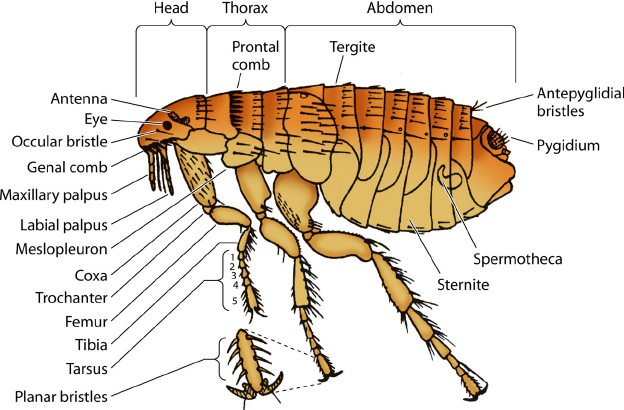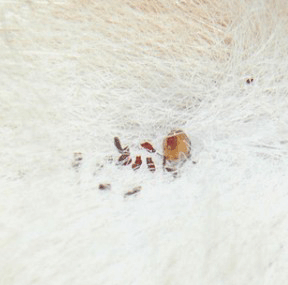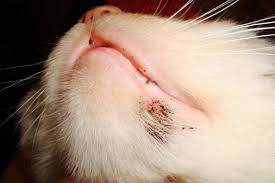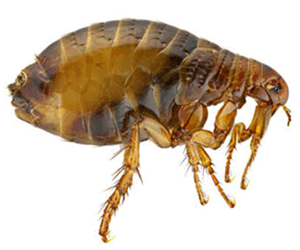What does it cost to employ the services of a flea control professional? Fleas are wingless parasitic insects that survive on the blood of warm-blooded animals. They possess well-built legs that help them get on their host with ease – even over distances of up to 12 inches. The reverse-bent spines on their legs also give them a firm grip on their host thereby making it extremely difficult to pick fleas off their hosts. Getting rid of fleas once they have infested your home can amount to serious work even after you’ve killed the adults because their eggs and larvae often hide in carpets, wall cracks and furniture.
Professional flea control cost is always a concern. To effectively eliminate fleas from your house, first of all find out how your house got infested with them and then treat the source in question before moving on to treating your entire house. Miscellaneous treatment including pet treatment, laundry and thorough house cleaning may increase the cost of getting rid of a flea infestation, but the average cost of exterminating fleas ranges around $95 for the first process, and $75 for subsequent inspections.
Various Species of Flea
While there are over 2000 species of fleas in the world, only the following are commonly responsible for most infestations around the house:

Human Fleas:
This species of fleas thrive on human blood and are usually found in human hair.
Dog Fleas:
Dogs are the most common hosts for this type of flea.
Bird Fleas:
This species of fleas prefer to have birds and poultry animals as their hosts. Nonetheless, they can also feed on other animals.
Cat Fleas:
Although this species of fleas may feed on human, dog and bird blood, they are most commonly found on cats.
Oriental Rat fleas:
These fleas feed predominantly on mice and rats.
Rodent Fleas:
Rabbits, mice and rats are usually the top on the list of hosts for this species of fleas even though human beings and pets are often their hosts.
General and Health Issues Associated with Fleas
It is best not to have fleas in your home at all because their infestations can be extremely difficult to eliminate. Also, professional flea control cost can be a concern. This is because they reproduce very quickly (with the female flea capable of laying up to 100 eggs on a daily basis) and fresh infestations may be lurking in their eggs and larvae hidden in holes and cracks even after you’ve killed the mature ones.
While anemia may result from fleas constantly feeding on the blood of a host, allergic rhinitis and itching can also result. Even if all fleas are not pathogen carriers, most of them are likely to transmit deadly diseases such as Bubonic plague, tapeworms, typhus fever and cat scratch disease. It is best to get rid of them immediately they are discovered because there are no tests to ascertain which flea is disease-carrying and which is not.
Detecting a Flea Infestation
Fleas are not very easily detected because for one thing, they’re very tiny and almost microscopic and are hard to spot. Secondly, their bites can be mistaken for those of similar insects like mosquitoes. One sure way to detect fleas is by looking out for their ‘dirt’ on your pets and their sleeping areas or spots where they’re commonly found.
While every cluster of black spots you see may not be flea dirt, flea ‘dirt’ is usually identified by a cluster of black spots comprising of flea excreta and dried hosts’ blood. To ascertain the presence of flea dirt, soak a paper towel in water and spread bits of it around the cluster. If it is flea dirt, it would disperse and the blood would form a reddish coloration in the water.
You can also visibly spot fleas (usually less than half a centimeter in size) leaping from your pet to their bedding or from one part of their body to another.
A flea infestation may also be detected by frequent bites in the ankle area and your pets may begin to scratch intensely or have their hairs fall off abnormally.
Necessary Effort
In dealing with a flea infestation, it is necessary to take certain steps meticulously to ensure it does not become widespread. The first step usually involves a thorough examination to establish the presence of fleas, followed by an adequate treatment of the host involved. Inspections can be carried out at no additional cost. There will however be a cost for professional flea control treatment.
Flea hosts (which are most often pets) can be treated either by the administration of topical or oral medicine by a vet or thorough flea wash to get rid of fleas and their larvae on your pets.
Your veterinary doctor should be able to help you decide on which treatment is best for your pet because a good number of pet medications for flea are often administered with respect to the weights of the pets involved.
After Treating Your Pets
Once your pets have been treated, they should be kept as far away from your house as possible until the treatment for your house has been successfully completed so that fresh infestation does not occur.
A bottle of flea wash for your pet may cost up to $10 while topical or oral medications may cost around $40-$50. Also, your veterinarian may charge an extra $50 as visit fee if he/she is to administer the treatment to your pets.
When it comes to treating your house, vacuuming is usually the first action to be taken. Most pest management firms may carry out this step in their procedure or possibly allow you do it on your own. During the process of vacuuming, ensure that every corner of your house is accessed by the vacuum cleaner – especially furniture, pet bedding, carpets and wall fissures. A proper vacuuming ensures that the eggs – which are not usually affected by chemicals – are exposed and easily destroyed.
The use of pest-killing chemicals always succeeds vacuuming so that the exposed fleas can be killed. A complete house treatment typically takes up to six hours and may cost up to $100 for the initial treatment. This amounts to a total of almost $150 for the treatment of both your pet and your house.
Further Visitations
Given the nature of a flea’s life cycle, pest control firms may suggest further visits for an interval of one to two months to ensure there is no fresh infestation. These additional visits can increase the professional flea control cost up to $75 and serve the purposes of killing recently hatched adults before they can begin reproduction.
Advanced Costs
Advanced measures such as washing your carpets to remove dead fleas and their dirt may cost you an additional $60 for each room in your house and also, administering flea prevention treatments on your pets may incur an extra $60 in costs.
Supplemental Points to Note
Your house is more likely to be declared flea-free if you’ve had successions of visits from your pest control firm and your pets have been treated for further flea prevention. This may increase flea control costs but will prevent reinfestation.
If after treatment, your pets still pick up fleas, your yard may need thorough treatment. You can treat your yard by keeping it dry, exposing more areas to sunlight, generously dropping chips of cedar wood all over your yard and using diatomaceous earth or chemicals.
Ensure to establish that you’re actually dealing with fleas because bedbugs bite in very similar ways as fleas and can also be found in bedding. However, only fleas can be found around your pets and their bedding. Your pest management company should be able to help you figure out the exact insect you’re dealing with.



